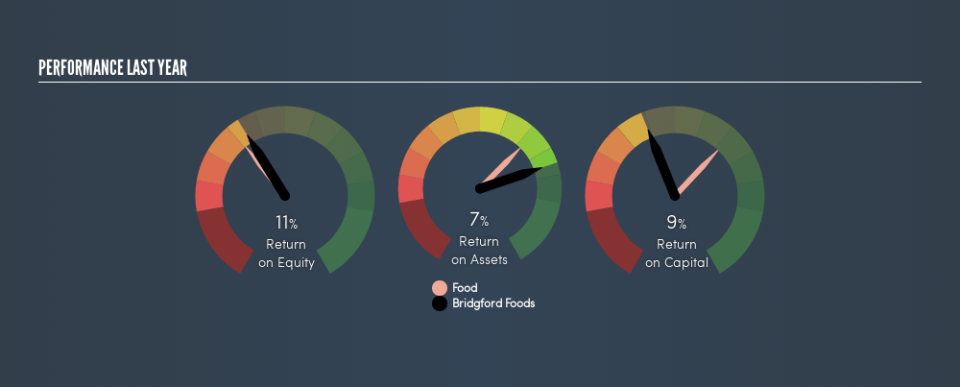Are Bridgford Foods Corporation’s Returns On Capital Worth Investigating?

Today we'll evaluate Bridgford Foods Corporation (NASDAQ:BRID) to determine whether it could have potential as an investment idea. Specifically, we're going to calculate its Return On Capital Employed (ROCE), in the hopes of getting some insight into the business.
Firstly, we'll go over how we calculate ROCE. Then we'll compare its ROCE to similar companies. And finally, we'll look at how its current liabilities are impacting its ROCE.
Understanding Return On Capital Employed (ROCE)
ROCE is a measure of a company's yearly pre-tax profit (its return), relative to the capital employed in the business. In general, businesses with a higher ROCE are usually better quality. Overall, it is a valuable metric that has its flaws. Renowned investment researcher Michael Mauboussin has suggested that a high ROCE can indicate that 'one dollar invested in the company generates value of more than one dollar'.
So, How Do We Calculate ROCE?
Analysts use this formula to calculate return on capital employed:
Return on Capital Employed = Earnings Before Interest and Tax (EBIT) ÷ (Total Assets - Current Liabilities)
Or for Bridgford Foods:
0.094 = US$8.6m ÷ (US$111m - US$19m) (Based on the trailing twelve months to April 2019.)
Therefore, Bridgford Foods has an ROCE of 9.4%.
Check out our latest analysis for Bridgford Foods
Does Bridgford Foods Have A Good ROCE?
ROCE can be useful when making comparisons, such as between similar companies. We can see Bridgford Foods's ROCE is around the 8.2% average reported by the Food industry. Setting aside the industry comparison for now, Bridgford Foods's ROCE is mediocre in absolute terms, considering the risk of investing in stocks versus the safety of a bank account. Investors may wish to consider higher-performing investments.
We can see that , Bridgford Foods currently has an ROCE of 9.4%, less than the 17% it reported 3 years ago. Therefore we wonder if the company is facing new headwinds. You can click on the image below to see (in greater detail) how Bridgford Foods's past growth compares to other companies.
It is important to remember that ROCE shows past performance, and is not necessarily predictive. ROCE can be deceptive for cyclical businesses, as returns can look incredible in boom times, and terribly low in downturns. ROCE is only a point-in-time measure. You can check if Bridgford Foods has cyclical profits by looking at this free graph of past earnings, revenue and cash flow.
Bridgford Foods's Current Liabilities And Their Impact On Its ROCE
Current liabilities are short term bills and invoices that need to be paid in 12 months or less. Due to the way the ROCE equation works, having large bills due in the near term can make it look as though a company has less capital employed, and thus a higher ROCE than usual. To check the impact of this, we calculate if a company has high current liabilities relative to its total assets.
Bridgford Foods has total liabilities of US$19m and total assets of US$111m. As a result, its current liabilities are equal to approximately 17% of its total assets. This is a modest level of current liabilities, which would only have a small effect on ROCE.
The Bottom Line On Bridgford Foods's ROCE
If Bridgford Foods continues to earn an uninspiring ROCE, there may be better places to invest. Of course, you might also be able to find a better stock than Bridgford Foods. So you may wish to see this free collection of other companies that have grown earnings strongly.
If you are like me, then you will not want to miss this free list of growing companies that insiders are buying.
We aim to bring you long-term focused research analysis driven by fundamental data. Note that our analysis may not factor in the latest price-sensitive company announcements or qualitative material.
If you spot an error that warrants correction, please contact the editor at editorial-team@simplywallst.com. This article by Simply Wall St is general in nature. It does not constitute a recommendation to buy or sell any stock, and does not take account of your objectives, or your financial situation. Simply Wall St has no position in the stocks mentioned. Thank you for reading.

 Yahoo Movies
Yahoo Movies 

